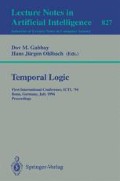Abstract
We present applications of the recently proposed Transaction Logic — an extension of classical logic that accounts in a clean and declarative fashion for the phenomenon of state changes in knowledge bases, including logic programs and databases. Transaction Logic has a natural model theory and a sound- and-complete proof theory, but unlike many other logics, it allows users to program transactions. Its semantics also leads naturally to features whose amalgamation in a single logic has proved elusive in the past. These features include both hypothetical and committed updates, static and dynamic constraints, nondeterministic actions, nested transactions, bulk updates, view updates, active databases, subjunctive queries, and more. Finally, Transaction Logic holds promise as a logical model of hitherto non-logical phenomena, including procedural knowledge in AI, and the behavioral aspect of object-oriented databases, especially methods with side effects. This paper outlines the model theory of Transaction Logic, and then focuses on some of its applications to AI, including action definition and execution, planning, and dynamic constraints.
Work supported in part by an Operating Grant from the Natural Sciences and Engineering Research Council of Canada and by a Connaught Grant from the University of Toronto.
Supported in part by NSF grant CCR-9102159. Part of this work is done during sabbatical year at the University of Toronto. Support of Computer Systems Research Institute of University of Toronto is gratefully acknowledged.
Preview
Unable to display preview. Download preview PDF.
References
S. Abiteboul and V. Vianu. Procedural and declarative database update languages. In ACM SIGACT-SIGMOD-SIGART Symposium on Principles of Database Systems (PODS), pages 240–250, 1988.
J.F. Allen. Towards a general theory of action and time. Artificial Intelligence, 23:123–154, July 1984.
F. Bancilhon. A logic-programming/Object-oriented cocktail. SIGMOD Record, 15(3):11–21, September 1986.
C. Beeri. New data models and languages—The challenge. In ACM SIGACT-SIGMOD-SIGART Symposium on Principles of Database Systems (PODS), pages 1–15, San Diego, CA, June 1992.
A.J. Bonner and M. Kifer. Transaction logic programming (or a logic of declarative and procedural knowledge). Technical Report CSRI-270, University of Toronto, April 1992. Revised: February 1994. Available in csri-technical-reports/270/report.ps by anonymous ftp to csri.toronto.edu.
A.J. Bonner and M. Kifer. Transaction logic programming. In Intl. Conference on Logic Programming (ICLP), Budapest, Hungary, June 1993.
A.J. Bonner and M. Kifer. An overview of transaction logic. Theoretical Computer Science, 133, October 1994.
A.J. Bonner, M. Kifer, and M. Consens. Database programming in transaction logic. In A. Ohori C. Beeri and D.E. Shasha, editors, Proceedings of the International Workshop on Database Programming Languages (DBPL), Workshops in Computing, pages 309–337. Springer Verlag, February 1994. Workshop held on Aug 30–Sept 1, 1993, New York City, NY.
W. Chen. Declarative specification and evaluation of database updates. In Intl. Conference on Deductive and Object-Oriented Databases (DOOD), volume 566 of Lecture Notes in Computer Science, pages 147–166. Springer Verlag, December 1991.
P.R. Cohen and E.A. Feigenbaum, editors. The Handbook of Artificial Intelligence, volume III. Addison-Wesley Publishing Co., 1986.
R.E. Fikes and N.J. Nilsson. STRIPS: A new approach to the application of theorem proving to problem solving. Artificial Intelligence, 2:189–208, 1971.
P.E. Friedland. Knowledge-Based Experiment Design in Molecular Genetics. PhD thesis, Computer Science Department, Stanford University, 1979. Report Number 79-771.
D. Harel, D. Kozen, and R. Parikh. Process Logic: Expressiveness, decidability, completeness. Journal of Computer and System Sciences, 25(2):144–170, October 1982.
H. Katsuno and A.O. Mendelzon. On the difference between updating a knowledge database and revising it. In Proceedings of the International Conference on Knowledge Representation and Reasoning (KR), pages 387–394, Boston, Mass., April 1991.
M. Kifer, G. Lausen, and J. Wu. Logical foundations of object-oriented and frame-based languages. Technical Report 93/06 (a revision of 90/14), Department of Computer Science, SUNY at Stony Brook, April 1993. To appear in Journal of ACM. Available in pub/TechReports/kifer/flogic.ps.Z by anonymous ftp to cs.sunysb.edu.
V. Lifschitz. On the semantics of STRIPS. In Reasoning about Actions and Plans: Proceedings of the 1986 Workshop, Timberline, OR, 1987. Reprinted in Readings in Planning, J. Allen, J. Hendler, A. Tate (eds.), Morgan-Kaufmann, 1990, 523–530.
S. Manchanda and D.S. Warren. A logic-based language for database updates. In J. Minker, editor, Foundations of Deductive Databases and Logic Programming, pages 363–394. Morgan-Kaufmann, Los Altos, CA, 1988.
S. Naqvi and R. Krishnamurthy. Database updates in logic programming. In ACM SIGACT-SIGMOD-SIGART Symposium on Principles of Database Systems (PODS), pages 251–262, March 1988.
N.J. Nilsson. Principles of Artificial Intelligence. Tioga Publ. Co., Paolo Alto, CA, 1980.
G. Phipps, M.A. Derr, and K.A. Ross. Glue-Nail: A deductive database system. In ACM SIGMOD Conference on Management of Data, pages 308–317, 1991.
E.D. Sacerdoti. The non-linear nature of plans. In Intl. Joint Conference on Artificial Intelligence (IJCAI), pages 206–214, 1975. Also appears in Readings in Planning, pp. 162–170. Morgan Kaufmann, San Mateo, CA, 1990.
M.J. Stefik. Planning with Constraints. PhD thesis, Computer Science Department, Stanford University, 1980. Report Number 80-784.
Author information
Authors and Affiliations
Editor information
Rights and permissions
Copyright information
© 1994 Springer-Verlag Berlin Heidelberg
About this paper
Cite this paper
Bonner, A.J., Kifer, M. (1994). Applications of transaction logic to knowledge representation. In: Gabbay, D.M., Ohlbach, H.J. (eds) Temporal Logic. ICTL 1994. Lecture Notes in Computer Science, vol 827. Springer, Berlin, Heidelberg. https://doi.org/10.1007/BFb0013981
Download citation
DOI: https://doi.org/10.1007/BFb0013981
Published:
Publisher Name: Springer, Berlin, Heidelberg
Print ISBN: 978-3-540-58241-0
Online ISBN: 978-3-540-48585-8
eBook Packages: Springer Book Archive

